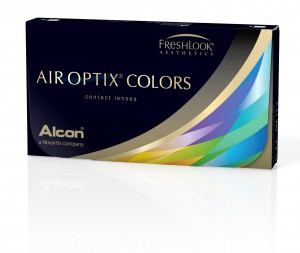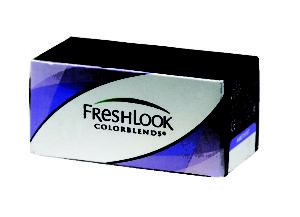Colored contact lenses
Leonardo da Vinci may have conceptualized contact lenses, but contact lens wear has only been in vogue for the past one hundred years. Colored contacts were introduced in the late 1930’s when a Metro Goldwyn Meyer (MGM) makeup artist approached a Beverly Hills ophthalmologist about the possibility of changing an actor’s eye color from brown to blue in an upcoming movie. The movie “Miracles for Sale” made history as the first to utilize color tinted contacts cosmetically. Since that time hundreds of movie effects were made possible by the actor wearing colored lenses.
Not only did they allow moviemakers to change an actor’s eye color from brown to blue or blue to green, colored contacts also opened the door for makeup artists who were able to implement characteristics for actors beyond eye color. For example, decorative lenses were used to portray blind eyes like Audrey Hepburn’s in the movie “Wait Until Dark”. Cosmetic lenses also made it possible to create the effect of scary eyes, as seen in the late Michael Jackson’s music video “Thriller”. Today the use of these types of lenses is commonplace in moviemaking, but you don’t have to be a movie star to wear them.
The basics of colored lenses
Like the name implies, colored contact lenses are tinted to change the appearance of your eye color. With adherence to a few guidelines, they are safe to wear and are available in many of the same categories as non-tinted contact lenses. Colored lenses are available to correct near and farsightedness and are available in soft or rigid gas permeable varieties. The same rules that govern safe wear of regular contact lenses apply to colored contacts. There are a few things you should keep in mind if you are considering wearing them for the first time or are contemplating a switch from regular lenses.
Tints and colors
It’s easy to change blue eyes to brown, or vice versa. Common eye colors aren’t that difficult to find. However, more imaginative colors are also available to contact lens wearers. Here are a few things to remember:
Visibility tinted contacts
These will not change the appearance of your eye color. The contacts are tinted just enough that the wearer can see them when placed in lens solution. Visibility tint makes it easier for the wearer to find the lens if it is dropped. The faint tinting is for handling purposes.
Enhancement tint contacts
These are the same color as your eyes – just slightly intensified. These lenses perform as indicated by their name, using a slightly darker color than your eyes, they’re meant to enhance your eye’s natural color.
Color tint contacts
These are for people who wish to completely change their eye color. Cosmetic or decorative contacts belong in this category and can even change the appearance of the pupil’s shape.
Even if you don’t need any vision correction, you’ll need a prescription from a doctor for colored contacts. That may seem a little silly, but contact lenses are a medical device. Anytime you put something on your eye you want to be sure that it is going to be safe and healthy for you.
Colored contact lenses are also known as decorative or cosmetic lenses
Contact lenses are federally regulated, and the FDA has warned consumers about the misuse of decorative and cosmetic lenses. Colored lenses are categorized as decorative, and unfortunately there have been reports of misuse resulting in harm to the wearer’s eyes. One problem is that disreputable vendors often sell these types of lenses. They market the lenses as beauty/cosmetic products or as fashion accessories. Buyers should beware of sellers that describe colored lenses in this way.
Unfortunately, there are a lot of colored and decorative lenses that are illegally sold online, at beauty shops, flea markets, or elsewhere that are not FDA approved. Always have a valid prescription for colored contacts and only purchase what is prescribed from a reputable source.
Potential risks associated with decorative lenses
Over-the-counter contact lenses may pose a danger to consumers since a prescription is not required for their purchase. This is not only dangerous, but also illegal. In the United States, contact lenses cannot legally be sold without a prescription. This is for good reason. Like all contact lenses, colored and decorative lenses are medical devices.
An ophthalmologist or optometrist should exam your eyes during the initial fitting, determine the prescription strength necessary, and measure your cornea to ensure the correct fit. If you already have a valid contacts prescription and want to try colored contacts you can take a 10-minute online vision test here.
If you have purchased a pair of colored contact lenses without a prescription or if you have experienced problems as a result, register a complaint with the Food and Drug Administration. Vendors who sell colored and decorative lenses illegally are subject to a $16,000 fine per offense.
The problem is not necessarily with decorative or colored lenses, but with the process by which they are illegally distributed and improperly used. Any lens that is not approved by the FDA should be considered dangerous to eye health. Decorative circle lenses, for instance, are not regulated and are considered hazardous, since they cover more of the eye’s surface than regular lenses. Circle lenses prevent the cornea from receiving oxygen, which is essential to eye health. Circle lenses also make the eye more susceptible to abrasions, and thereby, infections.
Caring for your colored lenses
Caring for colored lenses is an important part of maintaining healthy eyes, while improper handling may lead to undesirable consequences. Colored contacts need the same kind of attention given to regular contacts. Thorough cleaning will protect against possible infections.
Follow the manufacturer’s directions for cleaning your contacts, and keep in mind the following:
- Do not wear contacts for longer than recommended by your eye care professional, and replace the lenses as directed.
- Take out your contacts before you go to sleep.
- Wash hands before handling contacts, then dry hands thoroughly with a lint-free cloth.
- Only use the contact solution that is designed for your contacts. Don’t use water as a replacement for solution.
- Don’t reuse the solution.
- Avoid wearing contacts while swimming or in hot tubs.
- Saline should not be used to disinfect lenses. Use only the solution designed for your colored contacts.
- Keep the contact lens case clean by rinsing with solution and airing out to dry.
- Replace your lens case every three months. Replace broken cases to avoid contamination.
- Keep the lens solution in its original container. Transferring solution risks contamination. Additionally, keep the bottle as sterile as possible. Don’t allow the tip of the bottle to touch anything. Don’t use old solution and do not add to the solution that is already in the case.
- Clean lenses by rubbing them between your fingers then follow by rinsing with contact solution.
The absolute most important thing to remember before wearing colored contact lenses for the first time is to purchase them from a reputable vendor that requires a prescription. Ignoring proper practices outlined by the Federal Drug Administration could take the fun out of wearing colored lenses.







